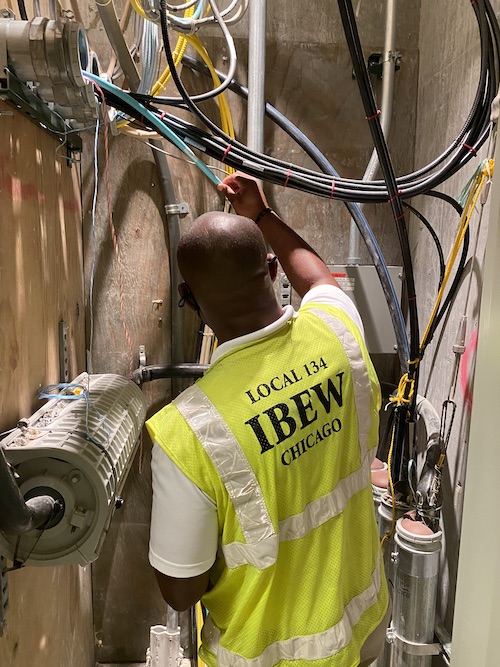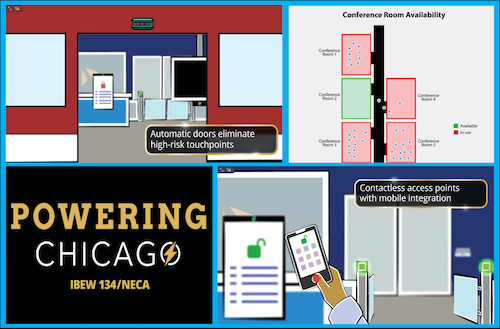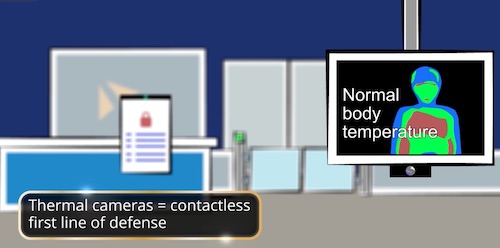The Loop is Chicago’s heartbeat, 35 snug blocks of landmarks and skyscrapers that draw hundreds of thousands of workers, shoppers, diners and tourists on a normal day.

|
|
Elbert Walters, Powering Chicago director and former Local 134 business agent, checks out cables at a downtown high-rise where IBEW electricians are installing and upgrading equipment that will help employers protect workers from COVID-19 exposure, including technology to improve the communications network between the office and employees working from home.
|

|
|
An animated video from Powering Chicago guides employers through the steps they can take to safeguard offices against COVID-19 and other contagions. Learn more at PoweringChicago.com/contactlessoffice
|

|
|
Chicago Local 134 and its electrical contractor partners were determined to be part of the solution when COVID-19 shut down their city. Through “The Contactless Office: Powering Chicago to a Better Workplace for All,” they’re helping businesses adapt and prepare to reopen safely.
|
At “peak corona,” as Local 134 steward Jimmy Aiello put it, “it was like the Twilight Zone.”
The journeyman wireman has spent every workday for a decade at the 54-story Blue Cross Blue Shield Tower overlooking Millennium Park and Lake Michigan. “It was eerie,” he said. “You’d look at the window and it was like, ‘Where is everybody?’”
While there’s still a long way to go, Aiello’s been on the front lines of reviving America’s Second City. He’s carrying out a commitment made by Local 134 and Powering Chicago, the dynamic partnership between the local and the city’s Electrical Contractors’ Association.
Alarmed as their city shut down in late March and early April, Business Manager Don Finn and Powering Chicago leaders were determined to be part of the solution.
“There was a screeching halt to work going on downtown,” Finn said. “All the offices were working remotely.
“We knew the more we can get employers set up to reopen downtown, the more people will come back and that’s what makes Chicago’s economic engine run,” he said.
They put their heads together and came up with “The Contactless Office: Powering Chicago to a Better Workplace for All.”
Getting there took several months of brainstorming and strategy, said Elbert Walters, Powering Chicago director and a former Local 134 business agent. “The question was posed: how to return to work in some capacity and restore some semblance of the economic community that we had that was thriving before COVID-19,” he said.
Their program includes webinars that have been attended by hundreds of people, a detailed guidebook online, and personal outreach, all of it teaching businesses how technology can minimize contact with surfaces, promote social distancing and otherwise protect workers’ health as offices reopen.
The technology itself isn’t new. But it’s being adapted and upgraded to meet the demands of a contagious disease.
Coded keycards long used for entries and exit can be programmed for secure, contactless movement through office suites and elevators. To promote social distancing, there are digital panels that show how many people are inside a conference room and doors that stay shut from the outside when the new, lower capacity is reached. Thermal cameras in lobbies can check body temperatures. UV lights can be installed to kill germs.
“Behind the scenes, it’s still the same devices; it’s how they’re being utilized that’s different,” said Gene Kent, director of Local 134’s IBEW-NECA training center.
As the program helps steer the city toward a new, safe normal, it’s also starting to create work for Local 134 members and signatory contractors.
“Part of our marketing effort is to really get out there and create knowledge so that our contractors can go out and sell to existing customers, ‘This is what we can do for you,’” said John Donahue, executive director of Powering Chicago.
Generating jobs for his members right now, and in the months ahead, is imperative, Finn said. The pandemic has taken a huge toll, grounding non-essential construction, shrinking building maintenance crews, and cutting jobs at other Local 134 worksites.
Just as things were starting to look up, the local’s out-of-work list began growing again with fall’s fierce new wave of COVID-19 infections.
Finn is hopeful that as more businesses that embrace contactless office technology, more members will be drawing a paycheck again.
“Think about it,” he said. “If you got up out of your cube on a normal day, you touched the door in the hallway, you touched the bathroom door, the lobby door, you hit the light switches and elevator buttons — with everything being a pass-through, it has the potential to create a tremendous amount of work.”
The crew at the Blue Cross building can operate with as few as seven electricians, “but with all the projects right now, there are 32 of us,” Aiello said.
Their major focus is upgrading the building’s cellular antenna signals to increase data speeds, and also installing new radio-frequency identification (RFID) readers.
The technology has many functions. But in terms of COVID-19, RFID can be used for contact tracing in the event of an outbreak. The stronger antenna signals will improve cellular and data transmission as some employees return to the office and others continue to work remotely.
By October, Aiello was seeing more people in the neighborhood, more signs of life, and his own building was humming with a few more of its 6,000 workers. But it’s still empty enough that the installation project —originally scheduled for overnight shifts— is getting done ahead of schedule during the day.
The crew’s tasks directly related to COVID-19 have included wiring a system that checks temperatures as people peer at a screen on a pedestal, then sends the result to the lobby desk. Other building trades are busy, too, Aiello said, including union carpenters who are moving desks and remodeling office suites for social distancing.
Word is spreading about Powering Chicago’s innovative approach to the COVID-19 crisis. Leaders and staff are getting inquiries from other states, spurred by ads in area building trade publications with far-flung readership.
No matter how the pandemic — or whatever comes next — affects technology and how it’s deployed, Local 134 members are ready, Kent said.
“The training we do instills confidence in our apprentices that they have the skills to negotiate any challenge,” he said. “Even if it’s brand-new technology, we’re ready to install it with very little learning curve because we’re so well trained.”